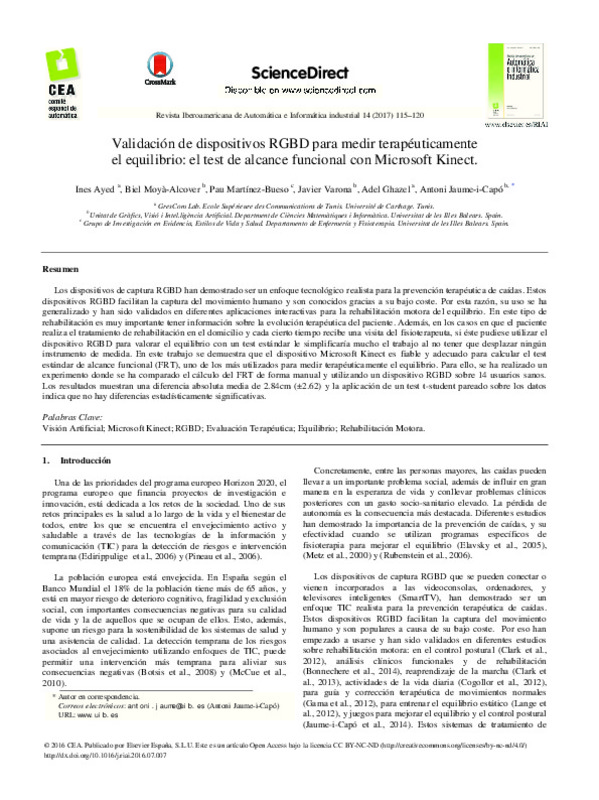Bonnechere, B., Jansen, B., Salvia, P., Bouzahouene, H., Omelina, L., Moiseev, F., ... & Jan, S. V. S., 2014. Validity and reliability of the Kinect within functional assessment activities: comparison with standard stereophotogrammetry. Gait & posture, 39(1), 593-598.
Botsis T, Demiris G, Pedersen S, Hartvigsen G, 2008. Home telecare technologies for the elderly. J Telemed Telecare. SAGE Publications;14(7):333-7.
Clark, R. A., Pua, Y. H., Fortin, K., Ritchie, C., Webster, K. E., Denehy, L., & Bryant, A. L., 2012. Validity of the Microsoft Kinect for assessment of postural control. Gait & posture, 36(3), 372-377.
[+]
Bonnechere, B., Jansen, B., Salvia, P., Bouzahouene, H., Omelina, L., Moiseev, F., ... & Jan, S. V. S., 2014. Validity and reliability of the Kinect within functional assessment activities: comparison with standard stereophotogrammetry. Gait & posture, 39(1), 593-598.
Botsis T, Demiris G, Pedersen S, Hartvigsen G, 2008. Home telecare technologies for the elderly. J Telemed Telecare. SAGE Publications;14(7):333-7.
Clark, R. A., Pua, Y. H., Fortin, K., Ritchie, C., Webster, K. E., Denehy, L., & Bryant, A. L., 2012. Validity of the Microsoft Kinect for assessment of postural control. Gait & posture, 36(3), 372-377.
Clark, R. A., Pua, Y. H., Bryant, A. L., & Hunt, M. A., 2013. Validity of the Microsoft Kinect for providing lateral trunk lean feedback during gait retraining. Gait & posture, 38(4), 1064-1066.
Cogollor, J. M., Hughes, C., Ferre, M., Rojo, J., Hermsdörfer, J., Wing, A., & Campo, S., 2012. Handmade task tracking applied to cognitive rehabilitation. Sensors, 12(10), 14214-14231.
Duncan, P. W., Weiner, D. K., Chandler, J., Studenski, S., 1990. Functional reach: a new clinical measure of balance. Journal of gerontology, 45(6), M192-M197.
Durfee, W. K., Savard, L., & Weinstein, S., 2007. Technical feasibility of teleassessments for rehabilitation. Neural Systems and Rehabilitation Engineering, IEEE Transactions on, 15(1), 23-29.
Edirippulige S, Wootton R, 2006. Telehealth and communication: Using the Internet in Healthcare. Heal Informatics Transform Healthc with Technol Sydney Thomson.
Elavsky S, McAuley E, Motl RW, Konopack JF, Marquez DX, Hu L, et al., 2005. Physical activity enhances long-term quality of life in older adults: Efficacy, esteem, and affective influences. Ann Behav Med.; 30(2):138- 45.
Forducey PG, Ruwe WD, Dawson SJ, Scheideman-Miller C, McDonald NB, Hantla MR. Using telerehabilitation to promote TBI recovery and transfer of knowledge. NeuroRehabilitation. 2002;18(2):103-11.
Galen, S. S., Pardo, V., Wyatt, D., Diamond, A., Brodith, V., & Pavlov, A. (2015). Validity of an Interactive Functional Reach Test. Games for health journal, 4(4), 278-284.
Gama, A. D., Chaves, T., Figueiredo, L., & Teichrieb, V., 2012. Guidance and movement correction based on therapeutics movements for motor rehabilitation support systems. In Virtual and Augmented Reality (SVR), 2012 14th Symposium on (pp. 191-200). IEEE.
Hailey D, Roine R, Ohinmaa A, Dennett L., 2010. Evidence on the effectiveness of telerehabilitation applications. Institute of Health Economics.
Hailey D, Roine R, Ohinmaa A, Dennett L, 2011. Evidence of benefit from telerehabilitation in routine care: a systematic review. J Telemed Telecare.
Huijgen, B. C., Vollenbroek-Hutten, M. M., Zampolini, M., Opisso, E., Bernabeu, M., Van Nieuwenhoven, J., ... & Marchese, S. S. (2008). Feasibility of a home-based telerehabilitation system compared to usual care: arm/hand function in patients with stroke, traumatic brain injury and multiple sclerosis. Journal of Telemedicine and Telecare, 14(5), 249-256.
Jaume-i-Capó, A., Martinez-Bueso, P., Moya-Alcover, B., Varona, J., 2014. Interactive rehabilitation system for improvement of balance therapies in people with cerebral palsy. Neural Systems and Rehabilitation Engineering, IEEE Transactions on, 22(2), 419-427
Keays, S. L., Bullock-Saxton, J. E., Newcombe, P., & Bullock, M. I., 2006. The effectiveness of a pre-operative home-based physiotherapy programme for chronic anterior cruciate ligament deficiency. Physiotherapy Research International, 11(4), 204-218.
Lange, B., Koenig, S., McConnell, E., Chang, C. Y., Juang, R., Suma, E., Rizzo, A., 2012. Interactive game-based rehabilitation using the Microsoft Kinect. In Virtual Reality Short Papers and Posters (VRW), 2012 IEEE (pp. 171-172). IEEE.
Lourido, B. P., & Gelabert, S. V., 2008. La perspectiva comunitaria en la fisioterapia domiciliaria: una revisión. Fisioterapia, 30(5), 231-237.
Lovallo C, Rolandi S, Rossetti AM, Lusignani M, 2010. Accidental falls in hospital inpatients: evaluation of sensitivity and specificity of two risk assessment tools. J Adv Nurs. Wiley Online Library;66(3):690-6.
McCue M, Fairman A, Pramuka M., 2010. Enhancing quality of life through telerehabilitation. Phys Med Rehabil Clin N Am.; 21(1):195-205.
Mehta, S. P., & Roy, J. S., 2011. Systematic review of home physiotherapy after hip fracture surgery. Journal of rehabilitation medicine, 43(6), 477- 480.
Metz D., 2000. Mobility of older people and their quality of life. Transp Policy. ;7(2):149-52.
Pineau G, Moqadem K, St-Hilaire C, Perreault R, Levac E, Hamel B, et al., 2006. Telehealth: clinical guidelines and technological standards for telerehabilitation. Montreal: Agence d'Evaluation des Technologies et des Modes d'Intervention en Sante (AETMIS).
Riolo, L. 2004. Attention contributes to functional reach test scores in older adults with history of falling. Physical & Occupational Therapy in Geriatrics, 22(2), 15-28.
Rubenstein LZ, Josephson KR, 2006. Falls and their prevention in elderly people: what does the evidence show? Med Clin North Am. Elsevier;90(5):807-24.
Russell, T. G., Wootton, R., & Jull, G. A. (2002). Physical outcome measurements via the Internet: reliability at two Internet speeds. Journal of telemedicine and telecare, 8(suppl 3), 50-52.
Russell, T. G., Buttrum, P., Wootton, R., & Jull, G. A. (2011). Internet-based outpatient telerehabilitation for patients following total knee arthroplasty. J Bone Joint Surg Am, 93(2), 113-120.
Savard L, Borstad A, Tkachuck J, Lauderdale D, Conroy B. Telerehabilitation consultations for clients with neurologic diagnoses: cases from rural Minnesota and American Samoa. NeuroRehabilitation. 2002;18(2):93- 102.
Varona, J., Jaume-i-Capó, A., Gonzàlez, J., & Perales, F. J. (2009). Toward natural interaction through visual recognition of body gestures in real-time. Interacting with computers, 21(1-2), 3-10.
[-]








